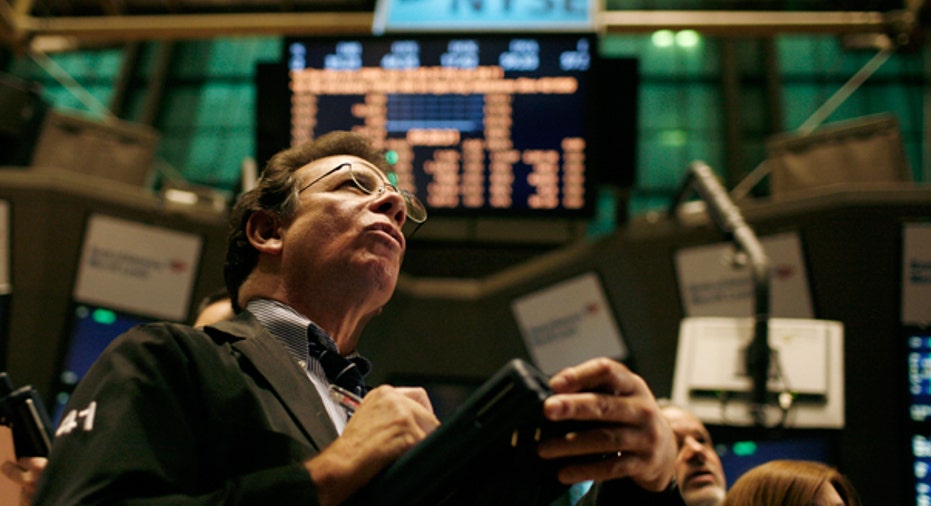Stocks End Near Session Highs as Rate Decision Nears

U.S. equity markets added substantially to slight gains on Tuesday after disappointing economic data had traders wondering how the Fed’s rate decision Thursday might be affected.
The Dow Jones Industrial Average was up 229 points, or 1.40% to 16600. The S&P 500 added 25 points, or 1.28% to 1978, while the Nasdaq Composite jumped 54 points, or 1.14% to 4860.
All 10 S&P 500 sectors were in positive territory with industrials and financials leading the climb.
Today’s Markets
Wall Street saw substantial gains as traders in the U.S. anxiously await the Federal Open Market Committee’s two-day policy-setting meeting, which begins Wednesday. At the conclusion of the meeting Thursday, the central bank will announce whether it will hike short-term interest rates from historic lows, or wait until the U.S. economy is on more solid footing after several months of global turmoil that included a worldwide market selloff on the heels of a surprise devaluation in the yuan, China’s currency as worries mounted about growth in the world’s second-largest economy.
While September was largely seen as the month in which the Federal Reserve would initiate liftoff for rates, in the last several weeks, major banks including Goldman Sachs (NYSE:GS) and Barclays (NYSE:BCS) have pushed out their original calls until December, and even March, thanks to the global uncertainty.
Scott Colyer, CEO of Advisors Asset Management, said he’s “squarely” in the camp that does not expect the Fed to hike at this week’s meeting, and even doesn’t see the first increase coming until next year.
“The market will be much better off after the Thursday announcement,” he said. “We’re just spending way too much time trying to figure out if the Fed will move on a quarter of a point. I don’t even know if the market would take it as a positive or negative if it doesn’t move. Remember, the last time the Fed raised rates was ’06 and I’m not sure any of us even remember what that’s like.”
The central bank has repeatedly said it would remain dependent on economic data in the U.S. as a benchmark to raising rates, and there was no shortage of releases on the calendar ahead of Thursday’s announcement. On Tuesday traders got the latest snapshot of retail sales, which includes an early portion of the back-to-school shopping season. Sales rose 0.2% in August, slightly below the 0.3% increase Wall Street expected. Excluding the volatile auto component, sales ticked up 0.1% compared to forecasts for a gain of 0.2%.
The latest reading to the Empire State manufacturing gauge from the New York Federal Reserve showed factory activity in the region remained deeply rooted in contraction territory. The gauge rose to -14.67 in September from -14.92 in August, the lowest level since 2009. Economists predicted the gauge would recover more to -0.75.
“[The data are] not showing much in the way of progress or something that would indicate the economy is on fire or about to become on fire,” Colyer said. “The Fed has to look at it and ask: What is our job. It’s a dual mandate of fully employment and low prices…we have slow growth at best, and the rest of the world is seemingly faltering.”
On Wednesday, Wall Street will get the latest update to the Labor Department’s consumer price index, and on Thursday, weekly jobless claims, housing starts, in addition to the latest reading on mid-Atlantic manufacturing activity.
As the U.S. waited for a rate decision, so too did global markets, where indexes saw mostly gains.
In Europe, the Euro Stoxx 50, which tracks large-cap companies in the eurozone rose 1.16%, while the German Dax gained 0.76%, and the French CAC 40 rose 1.32%. The UK’s FTSE 100 reversed course to rise 1.06%.
“The London stock market is suffering the most across Europe, and the FTSE’s high exposure to mineral-related companies is behind the poor performance…we’ve gone from the commodity super cycle to the commodity super sell-off…the severe drop in commodity prices has trickled down to the cost of living, and the UK inflation level has slipped back to zero," David Madden, IG market analyst said.
Elsewhere in Asia, China’s Shanghai Composite dropped 3.52%, Hong Kong’s Hang Seng declined 0.49%, while Japan’s Nikkei climbed 0.34% after the nation’s central bank kept rates steady, but manufacturer confidence fell to an eight-month low.
In commodities, global oil prices recovered from the prior session’s losses. U.S. crude prices rose 1.34% to $44.59, while Brent, the international benchmark, rose 0.56% to $46.63.
Metals declined during the session: Gold slipped 0.44% to $1,102 a troy ounce, silver gave up 0.26% to $14.32 an ounce, while copper reversed course to rise 0.91% to $2.44 a pound.
The U.S. dollar was mixed against a handful of global currencies as the euro declined 0.43% against the greenback. Meanwhile, the yield on the benchmark 10-year U.S. Treasury bond rose 0.083 percentage point to 2.263. Yields move in the opposite direction of prices.



















